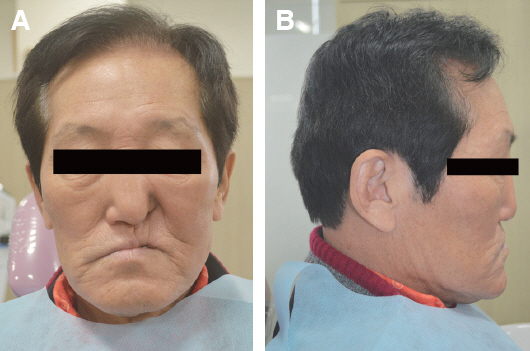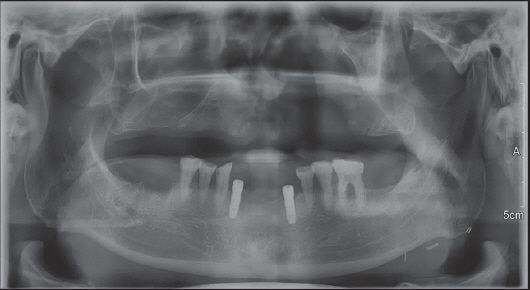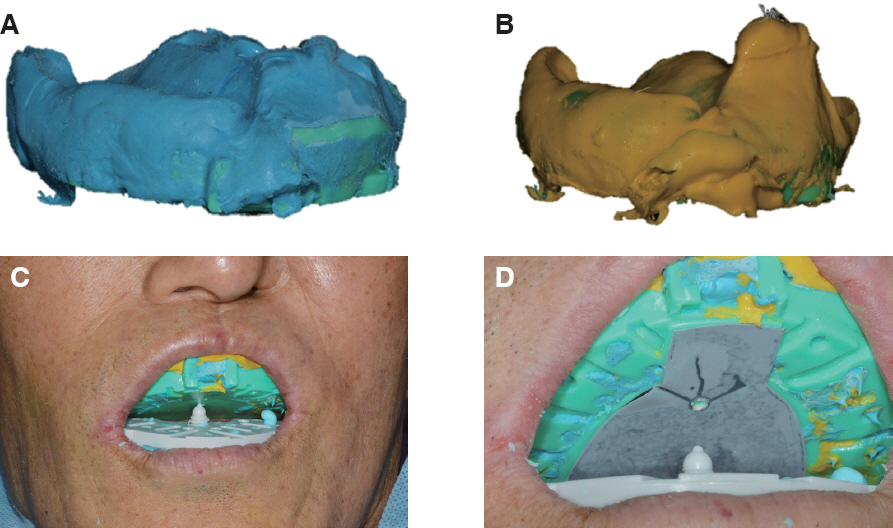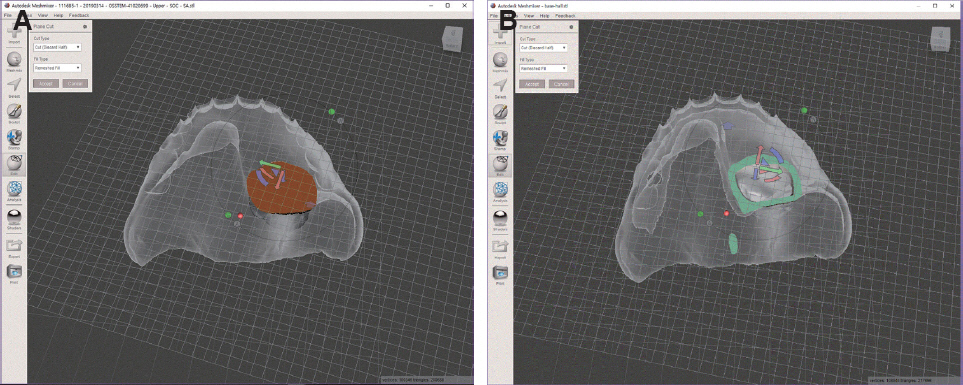J Dent Rehabil Appl Sci.
2019 Sep;35(3):191-198. 10.14368/jdras.2019.35.3.191.
Prosthetic rehabilitation for a maxillectomy patient using 3D printing assisted closed hollow bulb obturator: a case report
- Affiliations
-
- 1Department of Prosthodontics, College of Dentistry, Dankook University, Cheonan, Republic of Korea. hyuk928@chol.com
- KMID: 2463628
- DOI: http://doi.org/10.14368/jdras.2019.35.3.191
Abstract
- This case report presents a closed hollow bulb obturator made by 3D printing for a maxillectomy patient. Final impression was taken according to the instructions and impression trays provided by the Magic dentureâ„¢ system. Vertical dimension, facial appearance, and retention had been checked with the try-in denture. The try-in denture was corrected and adjusted to fulfill the demand of the patients, then these were reflected to the final design of the denture. The defect area was designed as a closed hollow bulb shape to reduce the weight and to provide uniform thickness of the denture. The patient satisfied with the esthetics and function of the denture.
Keyword
MeSH Terms
Figure
Reference
-
References
1. Irish J, Sandhu N, Simpson C, Wood R, Gilbert R, Gullane P, Brown D, Goldstein D, Devins G, Barker E. Quality of life in patients with maxillectomy prostheses. Head Neck. 2009; 31:813–21. DOI: 10.1002/hed.21042. PMID: 19280665.2. Keyf F. Obturator prosthesis for hemimaxillectomy patients. J Oral Rehabil. 2001; 28:821–9. DOI: 10.1111/j.1365-2842.2001.00754.x. PMID: 11580820.3. Wang RR. Sectional prosthesis for total maxillectomy patients:a clinical report. J Prosthet Dent. 1997; 78:241–4. DOI: 10.1016/S0022-3913(97)70020-9. PMID: 9297638.4. Buzayan MM. The hollow bulb obturator fabrication, where do we stand in 2017. Periodont Prosthodont. 2017; 3:10. DOI: 10.21767/2471-3082.100035.5. Brown KE. Fabrication of a hollow-bulb obturator. J Prosthet Dent. 1969; 21:97–103. DOI: 10.1016/0022-3913(69)90035-3. PMID: 4881714.6. Krishna CH, Babu JK, Fathima T, Reddy GV. Fabrication of a hollow bulb prosthesis for the rehabilitation of an acquired total maxillectomy defect. BMJ Case Rep. 2014; Mar. 26. 2014:pii:bcr2013201400. doi:10.1136/bcr-2013-201400. DOI: 10.1136/bcr-2013-201400. PMID: 24671313. PMCID: PMC3975568.7. Dawood A, Marti Marti B, Sauret-Jackson V, Darwood A. 3D printing in dentistry. Br Dent J. 2015; 219:521–9. DOI: 10.1038/sj.bdj.2015.914. PMID: 26657435.8. Tasopoulos T, Kouveliotis G, Polyzois G, Karathanasi V. Fabrication of a 3D printing definitive obturator prosthesis:a clinical report. Acta Stomatol Croat. 2017; 51:53–8. DOI: 10.15644/asc51/1/7. PMID: 28740271. PMCID: PMC5506255.9. Kattadiyil MT, Jekki R, Goodacre CJ, Baba NZ. Comparison of treatment outcomes in digital and conventional complete removable dental prosthesis fabrications in a predoctoral setting. J Prosthet Dent. 2015; 114:818–25. DOI: 10.1016/j.prosdent.2015.08.001. PMID: 26412000.10. Brown JS, Rogers SN, McNally DN, Boyle M. A modified classification for the maxillectomy defect. Head Neck. 2000; 22:17–26. DOI: 10.1002/(SICI)1097-0347(200001)22:1<17::AID-HED4>3.0.CO;2-2. PMID: 10585601.11. Habib BH, Driscoll CF. Fabrication of a closed hollow obturator. J Prosthet Dent. 2004; 91:383–5. DOI: 10.1016/j.prosdent.2004.01.020. PMID: 15116041.12. Sreeramulu B, Shalini K, Swapna B, Suman P, Venkata Ratana Kumar R. Alternative technique for fabrication of hollow bulb obturator for hemimaxillectomy patient - a case report. Int J Healthcare Biomed Res. 2014; 3:139–43.13. Patil PG, Nimbalkar-Patil S. Lost wax-bolus technique to process closed hollow obturator with uniform wall thickness using single flasking procedure. J Indian Prosthodont Soc. 2017; 17:84–8. DOI: 10.4103/0972-4052.176538. PMID: 28216851. PMCID: PMC5308074.14. Shrestha B, Hughes ER, Kumar Singh R, Suwal P, Parajuli PK, Shrestha P, Sharma A, Adhikari G. Fabrication of closed hollow bulb obturator using thermoplastic resin material. Case Rep Dent. 2015; 2015:504561. DOI: 10.1155/2015/504561. PMID: 26491575. PMCID: PMC4600497.15. Ushijima M, Kamashita Y, Nishi Y, Nagaoka E. Changes in lip forms on three-dimensional images with alteration of lip support and/or occlusal vertical dimension in complete denture wearers. J Prosthodont Res. 2013; 57:113–21. DOI: 10.1016/j.jpor.2012.11.003. PMID: 23265952.16. Kamashita Y, Kamada Y, Kawahata N, Nagaoka E. Influence of lip support on the soft-tissue profile of complete denture wearers. J Oral Rehabil. 2006; 33:102–9. DOI: 10.1111/j.1365-2842.2006.01575.x. PMID: 16457669.
- Full Text Links
- Actions
-
Cited
- CITED
-
- Close
- Share
- Similar articles
-
- Maxillofacial rehabilitation of hemi-maxillectomy patient using a closed hollow bulb obturator fabricated by one-step polymerization technique: a clinical report
- A hollow definitive obturator fabrication technique for management of partial maxillectomy
- Fabrication of closed hollow obturator for hard palate defect patient undergone maxillectomy
- Implant assisted obturator in patient after maxillectomy: a case report
- Prosthetic rehabilitation of partially edentulous patient after maxillectomy: A case report









